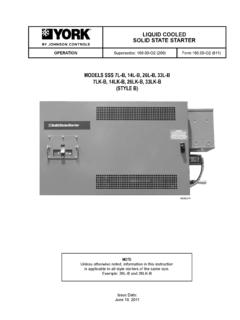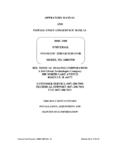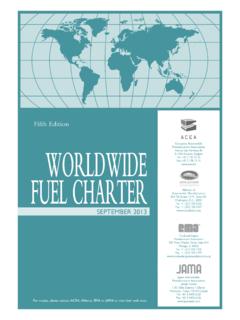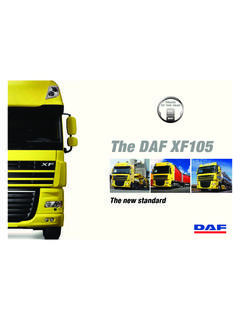Transcription of Andover Technology Partners
1 Andover Technology Partners Measuring Ammonia Slip from Post Combustion NOx reduction Systems By James E. Staudt Andover Technology Partners ABSTRACT. Unreacted ammonia, referred to as ammonia slip, can be a by-product of certain NOx reduction processes. Facilities with NOx reduction systems that experience substantial operating problems from ammonia slip are the exceptions rather than the rule. This is largely due to improved understanding of Technology application and also due to the fact that these systems are usually operated well within the operating envelopes in order to avoid problems with ammonia slip.
2 In many facilities there may be room for process improvement that could reduce operating costs or provide revenue enhancement opportunities. Operating SNCR or SCR Technology closer to its limit offers these benefits but increases the risk of high ammonia slip. The risk could be abated with the use of ammonia monitoring Technology . But, except for gas-fired plants, continuous ammonia slip monitoring technologies have not been available at a practical price to facilitate these cost-saving or revenue enhancing improvements. Conditions that exist in high dust, high temperature, high NOx and/or high SO2 environments make most analyzer methods of continuously measuring ammonia unsuitable for application to coal plants.
3 In this paper, the motivation to utilize ammonia slip monitoring Technology will be analyzed and quantified for an example plant. As will be shown, the benefits of monitoring ammonia slip are largely realized in the ability to operate a facility in a manner that permits facility income enhancement at a lower risk. Hence, the value is in risk reduction while revenue is enhanced. Finally, a brief overview of the technologies available for measuring ammonia in the high dust region downstream of a NOx reduction system and the status of their development will be provided.
4 ICAC Forum 2000. 2. Introduction For selective catalytic reduction (SCR) and selective Non- catalytic reduction (SNCR). technologies, the level of ammonia slip is normally controlled to levels that do not create operating problems or pollutant emission issues for users. Under the unlikely circumstances where high slip may occur, the types of problems ammonia slip can potentially contribute to are well documented and include: Formation of ammonium salts on air preheater and other downstream surfaces. Ammonium Chloride plume from the stack. Ammonia odor in fly ash.
5 Emission of gaseous ammonia. The first, second and third problems are of most concern to boiler operators, particularly the first. The third problem is of greatest concern to air regulators. This paper will not explore these problems in detail, since they are mostly well understood and operators of facilities and air regulators are well aware of them. Reference 1 evaluated the use of NOx reduction technologies on several utility boilers and found that significant operating problems due to ammonia slip were rare, although there were units identified in the study that experienced some air preheater buildup.
6 The level of slip that needed to be maintained to avoid problems varied. According to Reference 1, one unit experienced air heater plugging when ammonia slip exceeded 2 ppm while other plants could withstand higher ammonia slip levels up to 10. ppm. None of the facilities reported higher emissions than 10 ppm. While sulfur content of the fuel plays a major role in determining the level of slip that is associated with an onset of problems, boiler design, fly ash characteristics, and condition of the boiler (air in-leakage, etc.) all play a significant role. NOx reduction plants are normally operated well within the operating limits in order to avoid ammonia slip.
7 In many facilities there may be room for process improvement that could reduce operating costs or even provide the opportunity for revenue enhancement under allowance trading scenarios. However, such operation might risk higher slip. Ammonia slip monitoring Technology has not been available to facilitate such benefits with sufficient confidence that slip won't be a problem. To date, ammonia monitoring Technology application has been limited largely to natural gas fired applications or other clean gas applications. These applications could be addressed with existing monitoring techniques, such as UV photometry, ion mobility spectroscopy or differential NOx analysis following conversion of ammonia to NOx.
8 Conditions that exist in high dust, high temperature, high NOx and/or high SO2 environments have made these methods mostly unsuitable for application to coal plants. Moreover, most commercial embodiments of these instruments are such that a several minute time delay would exist, which may make them less useful as process control devices in SNCR or SCR systems. Therefore, other technologies must be used. However, before embarking on a description of Technology for measuring ammonia, it is worth considering the reasons for monitoring it. Andover Technology Partners 112 Tucker Farm Road, North Andover , MA 01845.
9 Phone: (978) 683-9599, fax: (978) 683-3843, e-mail: web site: 3. Benefits of Monitoring Ammonia The value of the benefit of monitoring ammonia slip continuously must exceed the cost or there would be no reason to pay the price of an ammonia slip monitoring instrument. Others who have considered this issue have focussed on the benefits of process optimization or avoidance of air preheater cleaning. These are good reasons to monitor ammonia. However, as will be shown, the argument may not be compelling in many cases. However, when the facility is operated closer to the limits of the Technology for the purpose of revenue enhancement, the argument becomes much more compelling.
10 Experience with SNCR and SCR systems in the on coal fired boilers documented in Reference 1 showed that only one of seventeen coal-fired boilers evaluated experienced an ammonium bisulfate deposition problem that forced shutdown or a derate. This one case was an unusually challenging SNCR system that required special injectors because of the required level of reduction , the boiler's size and furnace characteristics. In other cases, where air heater build up did occur, cleaning was performed during scheduled outages. Therefore, if SCR and SNCR systems continue to be operated as they have - well within their capabilities - it is reasonably unlikely that any particular boiler will experience air heater plugging that is so severe that it is forced to an unplanned shut down or take a derate.








